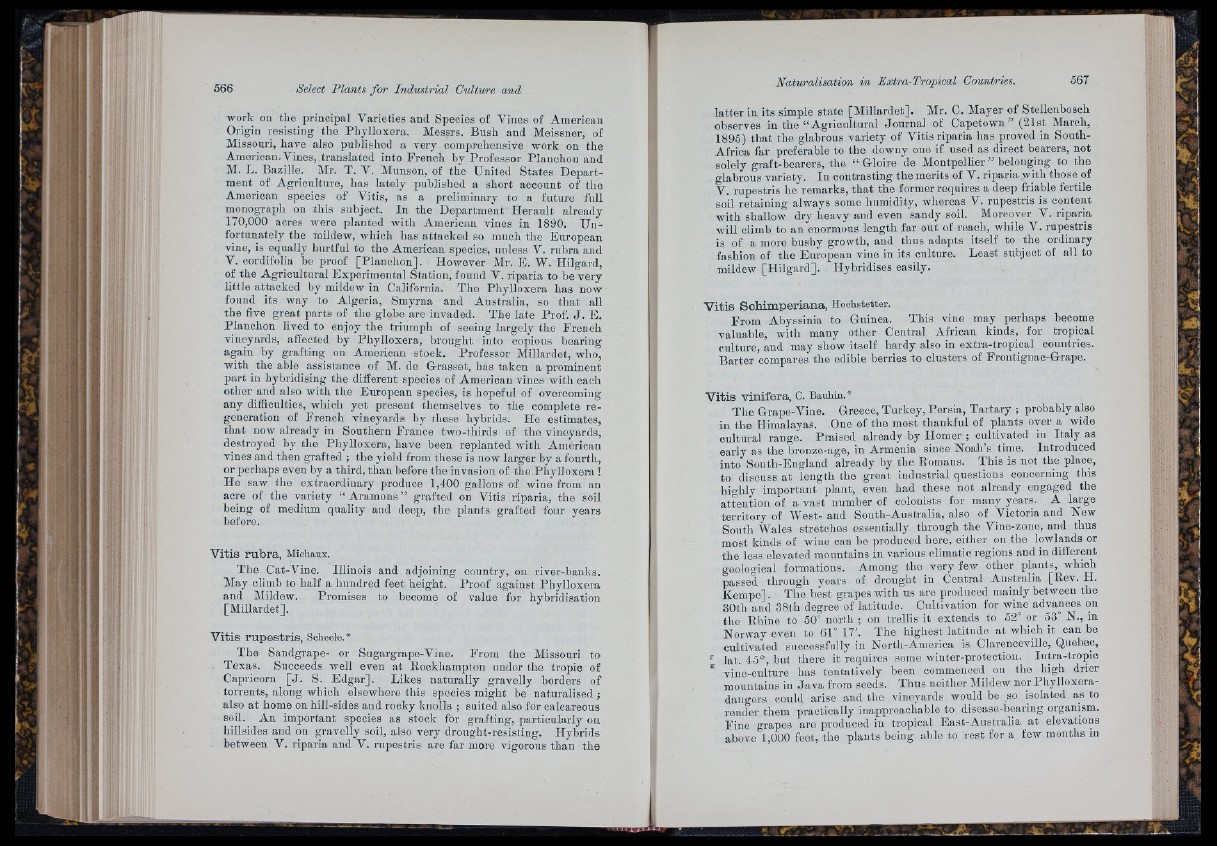
work on the principal Varieties and Species of Vines of American
Origin resisting the Phylloxera. Messrs. Bush aud Meissner, of
Missouri, have also published a very comprehensive work on the
American.Vines, translated into French by Professor Planchon and
M. L. Bazille. Mr. T. V. Munson, of the United States Department
of Agriculture, has lately published a short account of the
American species of Vitis, as a preliminary to a future full
monograph on this subject. In the Department Hérault already
170,000 acres were planted with American vines in 1890. U n fortunately
the mildew, which has attacked so much the European
vine, is equally luirtful to the American species, unless V. rnbra and
V. cordifolia be proof [Planolion]. However Mr. E. W. Hilgard,
of the Agricultural Experimental Station, found V. riparia to be very
little attacked by mildew in California. The Phylloxera has now
found its way to Algeria, Smyrna and Australia, so th a t all
the five great parts of the globe are invaded. The late Prof. J . E.
Planchon lived to enjoy the triumph of seeing largely the French
vineyards, affected by Phylloxera, brought into copious bearing
again by grafting on American stock. Professor Millardet, who,
with the able assistance of M. de Grasset, has taken a prominent
part in hybridising the different species of American vines with each
other and also with the European species, is hopeful of overcoming
any difficulties, which yet present themselves to the complete regeneration
of French vineyards by these hybrids. He estimates,
th a t now already in Southern France two-thirds of the vineyards,
destroyed by the Phylloxera, have been replanted with American
vines and then grafted ; the yield from these is now larger by a fourth,
or perhaps even by a third, than before the invasion of the Phylloxera !
He saw the extraordinary produce 1,400 gallons of wine from an
acre of the variety “ Aramons” grafted on Vitis riparia, the soil
being of medium quality and deep, the plants grafted four years
before.
Vitis rubra, Miohaux.
The Cat-Vine. Illinois and adjoining country, on river-banks.
May climb to half a hundred feet height. Proof against Phylloxera
and Mildew. Promises to become of value for hybridisation
[Millardet].
Vitis rupestris, Soheefe.*
The Sandgrape- or Sugargrape-Vine. From the Missouri to
Texas. Succeeds well even at Rockhampton under the tropic of
Capricorn [ J . S. Edgar]. Likes naturally gravelly borders of
torrents, along which elsewhere this species might be naturalised ;
also a t home on hill-sides and rocky knolls ; suited also for calcareous
soil. An important species as stock for grafting, particularly on
hillsides and on gravelly soil, also very droirght-resisting. Hybrids
between V. riparia and V. rupestris are far more vigorous than the
latter in its simple state [Millardet]. Mr. C. Mayer of Stellenbosch
observes in the “ Agricultural Journal of Capetown” (21st March,
1895) th a t the glabrous variety of Vitis riparia has proved in South-
Africa far preferable to the downy one if used as direct bearers, not
solely graft-bearers, the “ Gloire de Montpellier ” belonging to the
glabrous variety. In contrasting the merits of V. riparia with those of
V. rupestris lie remarks, th a t the former requires a deep friable fertile
soil retaining always some humidity, whereas V. rupestris is content
with shallow dry heavy and even sandy soil. Moreover V. riparia
will climb to an enormous length far out of reach, while V. rupestris
is of a more busliy growth, and thus adapts itself to the ordinary
fashion of the European vine in its culture. Least subject of all to
mildew [H ilg a rd ]. Hybridises easily.
V itis Schimperiana, Hochstetter.
From Abyssinia to Guinea. This vine may perhaps become
valuable, with many other Central African kinds, for tropical
culture, and may show itself hardy also in extra-tropical countries.
Barter compares the edible berries to clusters of Frontignao-Grape.
V itis vinifera, C. Bauhin.*
The Grape-Vine. Greece, Turkey, Persia, Tartary ; probably also
in the Himalayas. One of the most thankful of plants oyer a wide
cultural range. Praised already by Homer ; cultivated in Italy as
early as the bronze-age, in Armenia since Noah’s time. Introduced
into Sonth-England already by the Romans. This is not the place,
to discuss a t length the great industrial questions concerning this
highly important plant, even had these not already engaged the
attention of a vast number of colonists for many years. A large
territory of West- and South-Australia, also of Victoria and New
South Wales stretches essentially through the Vine-zone, and thus
most kinds of wine can he produced here, either on the lowlands or
the less elevated mountains in various climatic regions and in different
geological formations. Among the very few other plants, which
passed throngh years of drought in Central Australia [Rev. H.
Kempe]. The best grapes w ith us are produced mainly between the
30th and 38th degree of latitude. Cultivation for wine advances on
the Rhine to 50° north ; on trellis it extends to 52° or 53° N., in
Norway even to 61° 17'. The highest latitude at whirii it can be
cultivated successfully in North-America is Clarenceville, Quebec,
f iat. 45°, hut there it requires some winter-protection. Intra-tropic
^ vine-cnlture lias tentatively been commenced ou the high drier
monntains in Jav a from seeds. Thus neither Mildew nor Phylloxera-
dangers could arise and the vineyards would be so isolated as to
render them practically inapproachable to disease-bearing organism.
Fine grapes are produced in tropical East-Australia a t elevations
above 1,000 feet, the plants being able to rest for a few months m